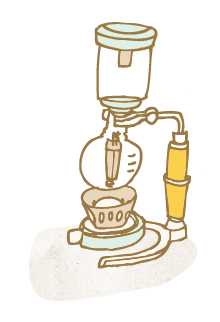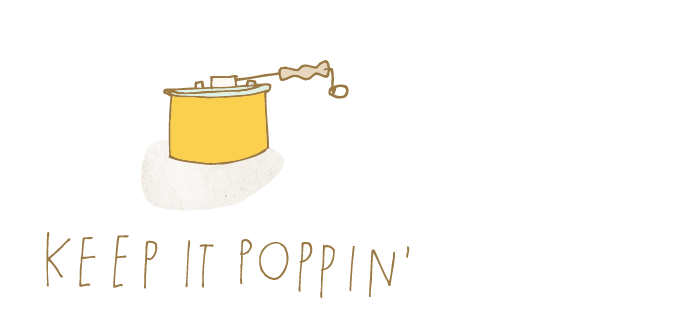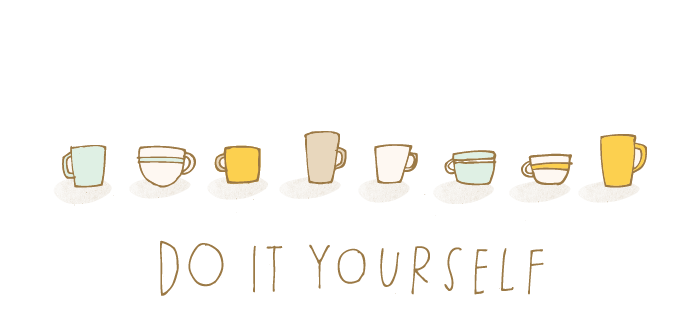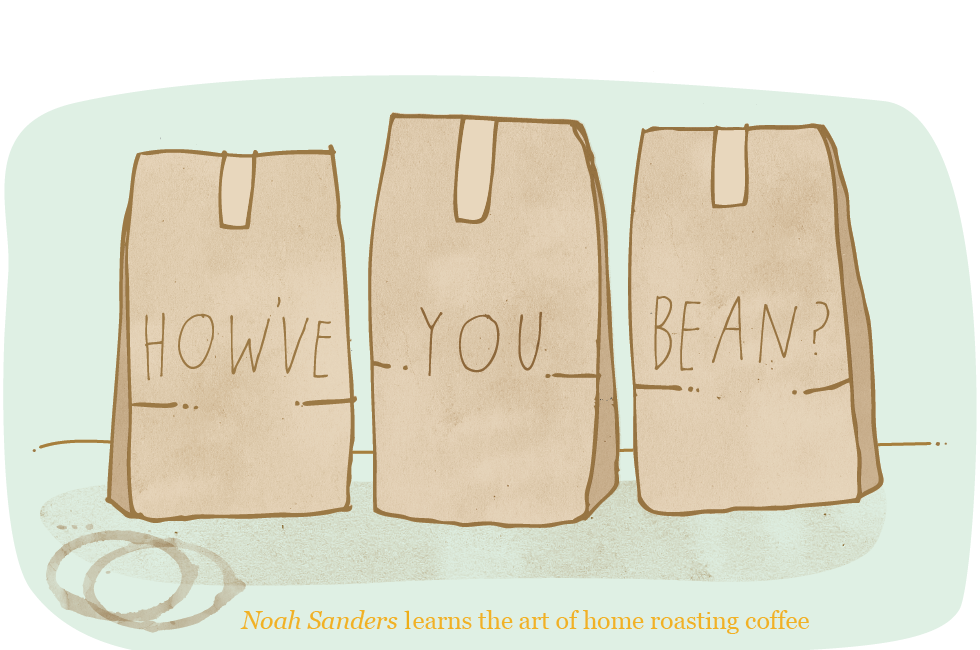
I’ve been drinking coffee for a good portion of my life. I’ve worked as a barista for years and now manage the coffee shop at Piccino in the Dogpatch, but in recent months my interests have moved from making coffee to knowing how to roast it. I want to know how to turn grassy green coffee beans into well-roasted ones to grind into drip and espresso. But I’ll never be able to afford or have space for the giant German roasters that big guns like Four Barrel and Sightglass use. I want something small, cheap and operational out of my kitchen.
Hell, I want to be a home roaster.

Before I can even think about roasting my own beans, I need a tutorial from home roasting professionals. I contact Ariana Akbar and her boyfriend James Kafader, who own and operate Brown Owl Coffee, a café on Taraval in Inner Parkside, who also run Hearth Coffee Roasters. They spend three days a week roasting beans in an industrial-grade roaster for their café and online sales. The couple are true coffee geeks by nature, and have developed and perfected a home-roasting technique that they’ve agreed to share with me.
When I arrive at their Inner Richmond house for a night of coffee roasting, I can’t find any evidence that coffee roasting happens here. It isn’t until Ariana pulls out several bags of Hawaiian Kona coffee and the pair lead me outside that I’m introduced to a bread box–sized device resembling a combination of something between a giant hair dryer and a toaster oven. “That’s the Behmor” James says. “Professional roasting hasn’t made any technological leaps and bounds in like 700 years. People are still pretty much turning beans over a fire.”
James and Ariana banter about ideal batch size and the proper heat curve for the size of bean we’re working with; both are particular to the roaster and the type of bean used. Ariana eventually divides the beans into three equal half-pound batches while James flips on the machine so it can achieve proper heating temperature. (James and Ariana conspiratorially fail to let me in on just what this temperature is.) I learn that we’re listening for “first crack,” a slight popping noise signaling that a certain amount of water vapor is being expelled from the beans and they’ve now reached a point where they’re roasted enough to taste like something. “Second crack” is a lighter, smaller crack. Home roasters try to find a roasting time somewhere amongst these cracks.
Ariana dumps the first batch into the spinning cylindrical cage and James hits a few buttons and that’s it. The machine gently hums and over the course of 15 minutes, a thin fog of coffee-scented smoke flits into the air. James, Ariana, and I listen to records and sip whiskey while the beans slowly turn, gaining in color and taste. Every once in a while, Ariana motions to James to turn down the music so we can listen for the hollow beat of the beans’ first crack, and James scoots over to the machine and presses a series of buttons.
When the batches are done and moved into a colander (to allow for any excess skin, or chaff, not removed by the machine, to be picked out), I ask them why home roasting fascinates them so much. James leans in and says, “It’s infinitely perfect-able. You can always do it better. You can always achieve a little bit more perfection.”
James and Ariana are more professional than I’m ever going to be. The Behmor sells for around $300 and on my meager funds that’s a long shot. I need a contact who roasts on the cheap. Mike Furlotti, an electrical engineer turned total coffee nerd who roasts out of his Cole Valley home, is this guy.


Mike and I sit cross-legged outside on his deck around his Hottop Coffee Roaster. I’m skeptical when I watch Mike dump two-thirds of a pound of beans into the homemade-looking contraption, a sort of mounted jet engine emblazoned with ’80s-style cursive lettering and a toylike control panel. Even more dubious as he stuffs a heat gun into the same hole.
“I built a better controller for the machine once, one that let you adjust your roast heating profiles more, but it was too much for the machine. So now I just use the heat gun,” Mike informs me. He smiles and adds, “I like to be able to control every variable. I build rockets and I shoot photographs because I can tweak all the variables to make [the process] completely my own. It’s the same with coffee.” We turn on the machine and sit in the sunlight and listen to the drum turn.
Mike picks at the chaff that slowly floats down from an opening in the machine and rubs it between his fingers. “I went through a period at the beginning where perfecting the process was everything, but I do this three times a week now. It’s the only coffee I drink and the process isn’t as interesting anymore. Now I’m interested in pinpointing exactly what I like to drink.” When the roast is done, Mike and I pick through the beans, pulling out the ones that are roasted too lightly, a product of the ever-changing variables — the moisture in the air, the barometric pressure, etc., that affect the roast process. “It isn’t a very precise procedure,” Mike tells me. “It’s a little bit different every time.”
We grind up a bit of what we make and drink it from the svelte vase-like form of a Japanese Hario siphon filter. The coffee, Ethiopian in origin, tastes like blueberries and I quaff down two or three cups as we stand in Mike’s kitchen staring out at his garden.


While impressed, I feel that Mike’s setup still seems outside the reach of your average wannabe roaster. I need to go down another step on the home roasting ladder. I need Andy Nahman. A complete amateur less than a year ago, Andy roasts from home, but has managed to acquire a bit of a following for his Pop & Mill brand coffee.
Andy uses a Whirley Pop, a traditional popcorn-making device that home roasters have repurposed. He makes no dice about his love for the process: “I like coffee, but I don’t really care about coffee. I just love being able to make a good cup of coffee for almost nothing.” The Whirley Pop is a $20 piece of machinery whose parts look like they’re from a movie theater popcorn machine. “I had to drill a hole in it so I could get a more accurate temperature reading. It still isn’t that precise, though.” The opening Andy has drilled allows him to read the temperature without opening the top of the pot, releasing crucial heat and muddying the consistency of the roast. After letting the Whirley Pop heat up for a couple minutes on his stove, Andy adds a carefully weighed half-pound of Rwandan beans and starts slowly turning the crank, keeping the beans moving. “I do this like twice a week. I just put on headphones and sit here listening to music, waiting for the coffee to roast.”
Andy’s roasting process is the simplest I’ve found so far. He sits and turns the crank until he hears the gentle pop of the first crack. The beans roast for several more minutes, then he dumps the contents into a colander. Outside we pick out the beans that sat too long on the edge becoming charred in the process. “It’s not a perfect process, man. I fucked up a batch just the other day and I’ve been doing this for like a year now.” In the kitchen Andy pulls out a box of Pop & Mill stamped bags and pours the half-pound in to it. “All you have to do is wait a couple days to drink it.” And that’s it: in a matter of 10, maybe 15 minutes, using only an adapted popcorn popper as his tool, Andy roasts me a batch of high-quality coffee.
I leave Andy’s home inspired by the seeming ease of his process. I’ve already ordered a pack of green coffee beans and as I wait for the bus, my mind is already racing. What heat curve will I use? Will I buy a Whirley Pop or splurge on a Behmor? Will I try the Ethiopian or Nicaraguan beans first? I step on to the bus, my mind alive with variables, knowing full well they’re all under my control.

Sweet Maria’s in Oakland is considered the nexus for all things involving home roasting. It’s got the green beans, the roasting equipment, and a website featuring a near encyclopedic amount of information about the wild world of home roasting. Get a four-pound sampler pack from Sweet Maria’s as well as a Whirley Pop, bring it home and let the good times roll.
If home roasting sounds too much of a pain, buy some pre-roasted beans from Hearth Coffee Roasters or just enjoy a cup of freshly brewed coffee at Brown Owl Coffee.







